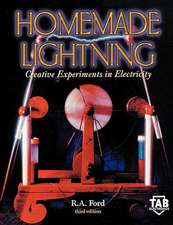High Speed CMOS Design Styles
Autor Kerry Bernstein, K.M. Carrig, Christopher M. Durham, Patrick R. Hansen, David Hogenmiller, Edward J. Nowak, Norman J. Rohreren Limba Engleză Paperback – 12 oct 2012
High Speed CMOS Design Styles provides a survey of design styles in use in industry, specifically in the high speed microprocessor design community. Logic circuit structures, I/O and interface, clocking, and timing schemes are reviewed and described. Characteristics, sensitivities and idiosyncrasies of each are highlighted. High Speed CMOS Design Styles also pulls together and explains contributors to performance variability that are associated with process, applications conditions and design. Rules of thumb and practical references are offered. Each of the general circuit families is then analyzed for its sensitivity and response to this variability.
High Speed CMOS Design Styles is an excellent source of ideas and a compilation of observations that highlight how different approaches trade off critical parameters in design and process space.
| Toate formatele și edițiile | Preț | Express |
|---|---|---|
| Paperback (1) | 948.29 lei 6-8 săpt. | |
| Springer Us – 12 oct 2012 | 948.29 lei 6-8 săpt. | |
| Hardback (1) | 953.52 lei 6-8 săpt. | |
| Springer Us – 31 aug 1998 | 953.52 lei 6-8 săpt. |
Preț: 948.29 lei
Preț vechi: 1156.45 lei
-18% Nou
Puncte Express: 1422
Preț estimativ în valută:
181.51€ • 197.23$ • 152.57£
181.51€ • 197.23$ • 152.57£
Carte tipărită la comandă
Livrare economică 21 aprilie-05 mai
Preluare comenzi: 021 569.72.76
Specificații
ISBN-13: 9781461375494
ISBN-10: 1461375495
Pagini: 376
Ilustrații: XIX, 353 p.
Dimensiuni: 155 x 235 x 20 mm
Greutate: 0.53 kg
Ediția:1999
Editura: Springer Us
Colecția Springer
Locul publicării:New York, NY, United States
ISBN-10: 1461375495
Pagini: 376
Ilustrații: XIX, 353 p.
Dimensiuni: 155 x 235 x 20 mm
Greutate: 0.53 kg
Ediția:1999
Editura: Springer Us
Colecția Springer
Locul publicării:New York, NY, United States
Public țintă
ResearchCuprins
1 Process Variability.- 1.1 Introduction.- 1.2 Front-End-Of-Line Variability Considerations.- 1.3 Charge Loss Mechanisms.- 1.4 Back-End-Of-Line Variability Considerations.- 1.5 Summary.- 2 Non-Clocked Logic Styles.- 2.1 Introduction.- 2.2 Static CMOS Structures.- 2.3 DCVS Logic.- 2.4 Non-Clocked Pass-Gate Families.- 2.5 Summary.- 3 Clocked Logic Styles.- 3.1 Introduction.- 3.2 Single-Rail Domino Logic Styles.- 3.3 Alternating-Polarity Domino Approaches.- 3.4 Dual-Rail Domino Structures.- 3.5 Latched Domino Structures.- 3.6 Clocked Pass-Gate Logic.- 3.7 Summary.- 4 Circuit Design Margin and Design Variability.- 4.1 Introduction.- 4.2 Process Induced Variation.- 4.3 Design Induced Variation.- 4.4 Application Induced Variation.- 4.5 Noise.- 4.6 Design Margin Budgeting.- 4.7 Summary.- 5 Latching Strategies.- 5.1 Introduction.- 5.2 Basic Latch Design.- 5.3 Latching Single-Ended Logic.- 5.4 Latching Differential Logic.- 5.5 Race Free Latches for Precharged Logic.- 5.6 Asynchronous Latch Techniques.- 5.7 Summary.- 6 Interface Techniques.- 6.1 Introduction.- 6.2 Signaling Standards.- 6.3 Chip-to-chip Communication Networks.- 6.4 ESD Protection.- 6.5 Driver Design Techniques.- 6.6 Receiver Design Techniques.- 6.7 Summary.- 7 Clocking Styles.- 7.1 Introduction.- 7.2 Clock Jitter and Skew.- 7.3 Clock Generation.- 7.4 Clock Distribution.- 7.5 Single Phase Clocking.- 7.6 Multi-Phase Clocking.- 7.7 Asynchronous Techniques.- 7.8 Summary.- 8 Slack Borrowing and Time Stealing.- 8.1 Introduction.- 8.2 Slack Borrowing.- 8.3 Time Stealing.- 8.4 Summary.- 9 Future Technology.- 9.1 Introduction.- 9.2 Classical Scaling Theory.- 9.3 Industry Trends Define Scaling Law.- 9.4 Challenges Presented by I/S Scaling.- 9.5 Possible Directions.






